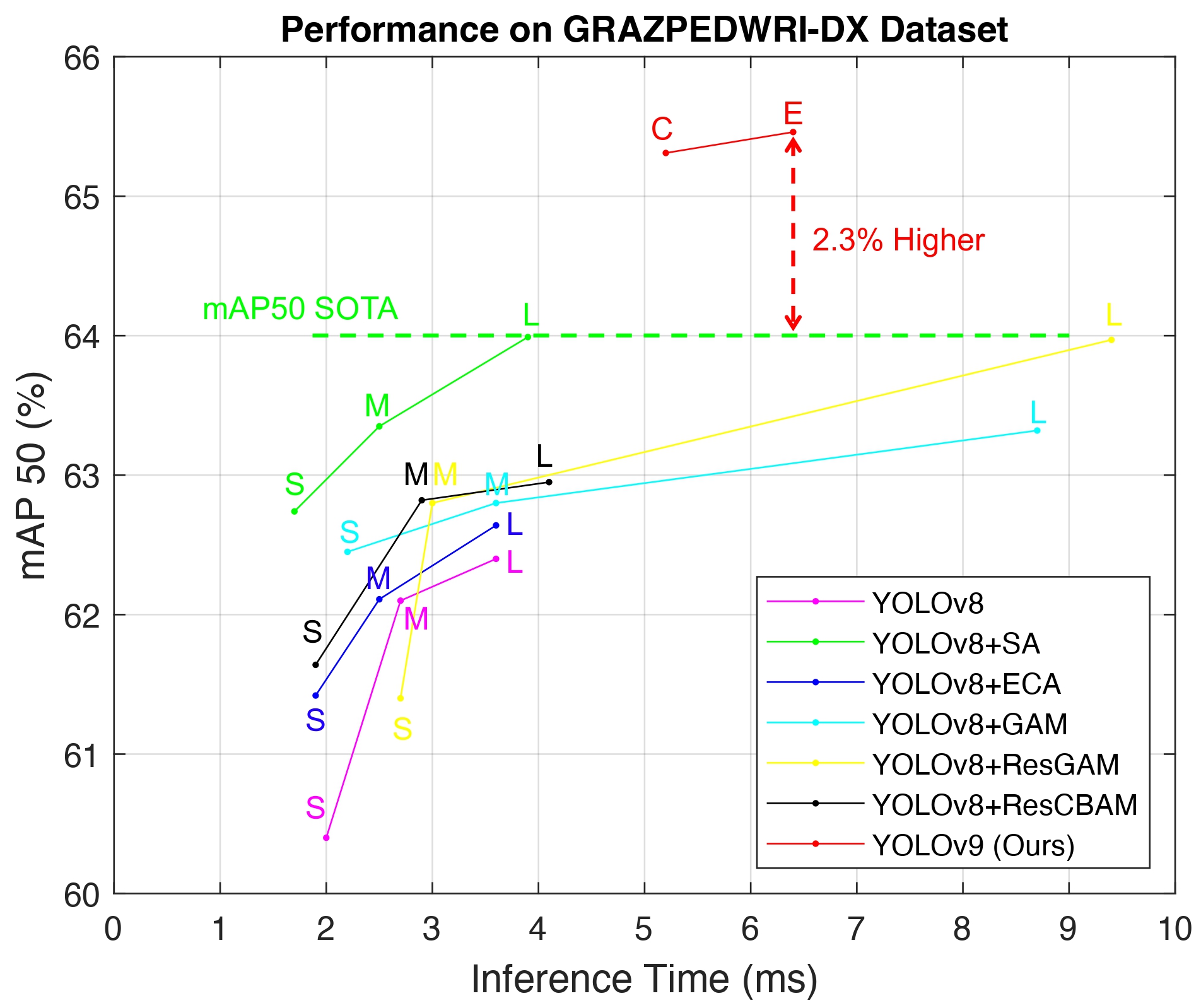YOLOv9 for Fracture Detection in Pediatric Wrist Trauma X-ray Images
| Model | Test Size | Param. | FLOPs | F1 Score | AP50val | AP50-95val | Speed |
|---|---|---|---|---|---|---|---|
| YOLOv8 | 640 | 43.61M | 164.9G | 0.59 | 62.44% | 40.32% | 3.6ms |
| YOLOv8+SA | 640 | 43.64M | 165.4G | 0.62 | 63.99% | 41.49% | 3.9ms |
| YOLOv8+ECA | 640 | 43.64M | 165.5G | 0.61 | 62.64% | 40.21% | 3.6ms |
| YOLOv8+GAM | 640 | 49.29M | 183.5G | 0.60 | 63.32% | 40.74% | 8.7ms |
| YOLOv8+ResGAM | 640 | 49.29M | 183.5G | 0.62 | 63.97% | 41.18% | 9.4ms |
| YOLOv8+ResCBAM | 640 | 53.87M | 196.2G | 0.62 | 62.95% | 40.10% | 4.1ms |
| YOLOv9-C | 640 | 51.02M | 239.0G | 0.64 | 65.31% | 42.66% | 5.2ms |
| YOLOv9-E | 640 | 69.42M | 244.9G | 0.64 | 65.46% | 43.32% | 6.4ms |
If you find our paper useful in your research, please consider citing:
@article{chien2024yolov9,
title={YOLOv9 for fracture detection in pediatric wrist trauma X-ray images},
author={Chien, Chun-Tse and Ju, Rui-Yang and Chou, Kuang-Yi and Chiang, Jen-Shiun},
journal={Electronics Letters},
volume={60},
number={11},
pages={e13248},
year={2024},
publisher={Wiley Online Library}
}
- Linux (Ubuntu)
- Python = 3.9
- Pytorch = 1.13.1
- NVIDIA GPU + CUDA CuDNN
pip install -r requirements.txt
-
GRAZPEDWRI-DX Dataset (Download Link)
-
Download dataset and put images and annotatation into
./GRAZPEDWRI-DX_dataset/data/images,./GRAZPEDWRI-DX_dataset/data/labels.python split.py -
The dataset is divided into training, validation, and testing set (70-20-10 %) according to the key
patient_idstored indataset.csv. -
The script then will move the files into the relative folder as it is represented here below.
GRAZPEDWRI-DX_dataset └── data ├── images │ ├── train │ │ ├── train_img1.png │ │ └── ... │ ├── valid │ │ ├── valid_img1.png │ │ └── ... │ └── test │ ├── test_img1.png │ └── ... └── labels ├── train │ ├── train_annotation1.txt │ └── ... ├── valid │ ├── valid_annotation1.txt │ └── ... └── test ├── test_annotation1.txt └── ...
The script will create 3 files: train_data.csv, valid_data.csv, and test_data.csv with the same structure of dataset.csv.
- Data augmentation of the training set using the addWeighted function doubles the size of the training set.
python imgaug.py --input_img /path/to/input/train/ --output_img /path/to/output/train/ --input_label /path/to/input/labels/ --output_label /path/to/output/labels/
For example:
python imgaug.py --input_img ./GRAZPEDWRI-DX/data/images/train/ --output_img ./GRAZPEDWRI-DX/data/images/train_aug/ --input_label ./GRAZPEDWRI-DX/data/labels/train/ --output_label ./GRAZPEDWRI-DX/data/labels/train_aug/
-
The path of the processed file is shown below:
GRAZPEDWRI-DX_dataset └── data ├── images │ ├── train │ │ ├── train_img1.png │ │ └── ... │ ├── train_aug │ │ ├── train_aug_img1.png │ │ └── ... │ ├── valid │ │ ├── valid_img1.png │ │ └── ... │ └── test │ ├── test_img1.png │ └── ... └── labels ├── train │ ├── train_annotation1.txt │ └── ... ├── train_aug │ ├── train_aug_annotation1.txt │ └── ... ├── valid │ ├── valid_annotation1.txt │ └── ... └── test ├── test_annotation1.txt └── ...
If you plan to use pretrained models to train, you need put them into ./weights/.
- You can get the YOLOv9 pretained models on the MS COCO 2017 Dataset through YOLOv9 official GitHub.
- Use gdown to download the trained model from our GitHub:
gdown https://github.com/RuiyangJu/YOLOv9-Fracture-Detection/releases/download/Trained/weights.zip
Before training the model, make sure the path to the data in the ./data/meta.yaml file is correct.
- meta.yaml
# patch: /path/to/GRAZPEDWRI-DX/data
path: 'E:/GRAZPEDWRI-DX/data'
train: 'images/train_aug'
val: 'images/valid'
test: 'images/test'
- Arguments
| Key | Value | Description |
|---|---|---|
| workers | 8 | number of worker threads for data loading (per RANK if DDP) |
| device | None | device to run on, i.e. device=0,1,2,3 or device=cpu |
| model | None | path to model file, i.e. yolov8n.pt, yolov8n.yaml |
| batch | 16 | number of images per batch (-1 for AutoBatch) |
| data | None | path to data file, i.e. coco128.yaml |
| img | 640 | size of input images as integer, i.e. 640, 1024 |
| cfg | yolo.yaml | path to model.yaml, i.e. yolov9-c.yaml |
| weights | None | initial weights path |
| name | exp | save to project/name |
| hyp | data/hyps/hyp.scratch-high.yaml | hyperparameters path |
| epochs | 100 | number of epochs to train for |
- Example
python train_dual.py --workers 8 --device 0 --batch 16 --data data/meta.yaml --img 640 --cfg models/detect/yolov9-c.yaml --weights weights/yolov9-c.pt --name yolov9-c --hyp hyp.scratch-high.yaml --min-items 0 --epochs 100 --close-mosaic 15


